Today most of us are up to date on the achievements accomplished by other countries in olden time. But did you know In India, The Jantar Mantars is a historical ensemble of astronomical instruments renowned for their observatories. These massive, multi-story red stone structures, with their intricate and impressive shapes, were constructed in the early 18th century by Maharaja Jai Singh II of Jaipur. They stand as a testament to the scientific ingenuity and architectural brilliance of ancient India.
Historical context of Jantar Mantars
During the early 18th century, the disintegration of the Mughal Empire led to political instability and fragmentation across India. Yet amidst this tumultuous period, regional rulers such as Jai Singh II took the opportunity to assert their independence and advance their cultural and scientific endeavors. Maharaja Sawai Jai Singh II — was a prominent leader of Jaipur in northwestern India during the 18th century.
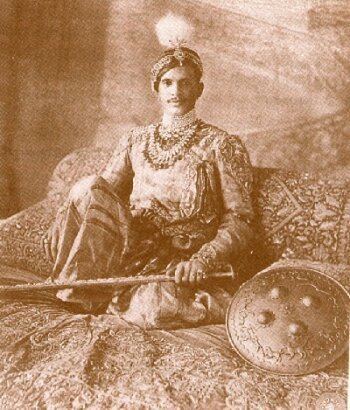
Credits:- Saudi Aramco World
Born on November 3, 1688, and crowned in 1699 while still a youth, He is most famously remembered for his significant contributions to astronomy— having constructed a network of five astronomical observatories during his reign that are located at key cities in India including Jaipur (Rajasthan), Delhi, Ujjain(Madhyapradesh), Varanasi(Uttarpradesh) and Mathura(Uttarpradesh).
Maharaja Sawai Jai Singh (November 3, 1688 – September 21, 1743) Was the Rajput Ruler of the Kingdom of Amber, Later Known as Jaipur. He Was the First Hindu Monarch in Centuries to Embark on a Significant Astronomical Journey in India.
Construction and Features of the Jantar Mantar Observatories:
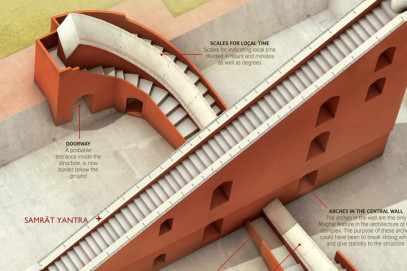
Jaipur (1724-1734):
The Largest and Most Complex, Featuring 19 Main Instruments. Its Construction Aimed to Improve the Accuracy of Celestial Measurement.
Delhi (1724):
Built to Improve on the Accuracy of the Zij-I-Muhammad Shahi Tables, The Observatory Played a Significant Role in the Mughal Court’s Astronomical Practices.
Ujjain (1725):
Ujjain’s Historical Significance as the Prime Meridian of India Made It a Natural Choice for One of the Observatories, Contributing to the Accuracy of Longitudinal Measurements.
Varanasi (1737):
Located on the Banks of the Ganges, It Integrated Traditional Astronomical Practices With New Instruments Designed by Jai Singh.
Mathura (1725):
Although the least known, its construction was part of the broader network of observatories aimed at covering different geographical locations for more comprehensive observations but the observatory at Mathura and the fort that protected was destroyed before 1857.
Mughal Emperor Muhammad Shah appointed Jai Singh to reform the calendar and advance the astronomical knowledge. This royal mandate gave Jai Singh the resources and authority needed to pursue his ambitious projects. Accurate timekeeping was crucial for daily life in those days, impacting agriculture, religious rituals, and astrology.
The existing astronomical tools and tables were inaccurate, motivating Jai Singh to develop more precise instruments. By building these observatories, Jai Singh aimed to make his kingdom a hub of scientific learning and innovation. This effort not only boosted his prestige but also highlighted his kingdom’s cultural and intellectual significance.
Astronomical Context of the Jantar Mantar
The Jantar Mantar observatories are renowned for their large-scale, fixed astronomical instruments, or yantras. These instruments were designed for precise astronomical measurements and were used for various purposes such as determining time, predicting eclipses, and tracking the positions of celestial objects. Below is an explanation of the astronomical context, yantras, their functions, workings, and specialities at each of the five Jantar Mantar observatories.
Jantar Mantar, Jaipur
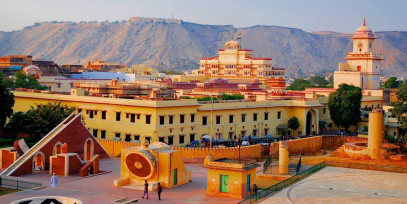
Credits : imagesofrajasthan.com
In Jaipur, the Samrat Yantra, standing 27 meters high, is the largest sundial in the world and measures time with an accuracy upto 2 seconds. The shadow of the gnomon (the triangular part) moves at a rate of 1 millimeter per second, indicating the time. The Jai Prakash Yantra, a concave hemisphere with surface markings, allows observers to stand inside and view the sky’s reflection to determine celestial positions.
The Ram Yantra, consisting of two circular buildings with a central pillar, measures the height and direction of celestial objects through the shadows cast on its walls. Other instruments like the Chakra Yantra and Digamsa Yantra, measure the declination of celestial objects and the sun’s azimuth, respectively.
Jantar Mantar, Delhi
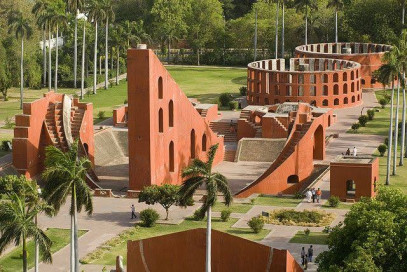
In Delhi, similar instruments like the Samrat Yantra and Jai Prakash Yantra serve timekeeping and determining celestial coordinates. The Misra Yantra, a composite of five different instruments, determines various astronomical parameters, including the shortest and longest days of the year and the exact moment of noon in different cities. The Rama Yantra and the Shastansh Yantra measure the zenith distance and celestial altitudes.
Jantar Mantar, Ujjain
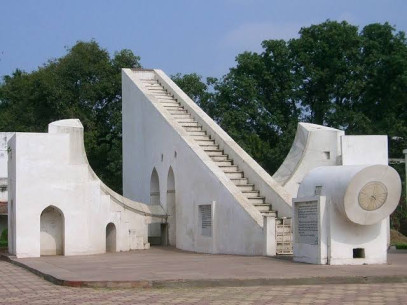
Credits: Angel Lahoz, Flickr
In Ujjain, the Nadivalaya Yantra measures the equatorial coordinates of celestial bodies using circular plates to observe both hemispheres. The Samrat Yantra is used for timekeeping and determining celestial zeniths, while The Digamsa Yantra measures the azimuth of celestial objects. The Shanku Yantra, a basic gnomon, is used to identify the summer and winter solstices.
Jantar Mantar, Varanasi
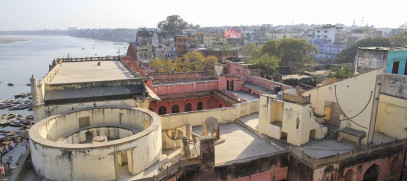
Credits : kevin standage photography
In Varanasi, the Chakra Yantra measures the declination of celestial objects. The Digamsa Yantra measures azimuth, and the Disha Yantra determines the direction of celestial bodies. The Samrat Yantra serves to measure time and observe the positions of celestial bodies.
Jantar Mantar, Mathura
In Mathura, the Dhruva Yantra was employed to determine the position of the Pole Star, while the Kapala Yantra was utilized to measure the positions and movements of celestial bodies. The Samrat Yantra was used to employed for determining time and celestial zeniths, the Digamsa Yantra measures the azimuth of celestial bodies.
Did you know our Pole star will change? Click here to know more!
Speciality and Working of Yantras in the Jantar Mantras:
Samrat Yantra:
Primarily for timekeeping, the Samrat Yantra features a triangular gnomon whose shadow moves uniformly across a marked scale. The scale is marked with hours, minutes, and seconds, allowing the time to be read with an accuracy of about 2 seconds. It also helps in determining the declination and altitude of celestial bodies by the shadow it casts.
The Samrat Yantra, Sometimes Called “Supreme Instrument” Is an Equinoctial Sundial of Enormous Proportion.
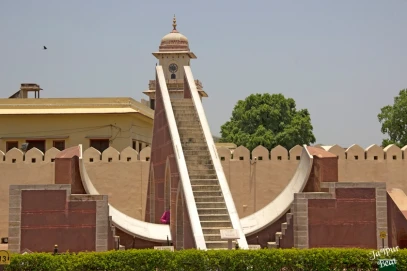
Jai Prakash Yantra:
This instrument serves to measure the positions of celestial bodies. The observer looks at the reflection of the sky on the surface of the bowl, where the positions of celestial objects can be directly read off the etched coordinates. It helps in determining the celestial equator and the ecliptic plane.
The Jayprakash Yantra, Is the Most Intriguing Yantra in Jaipur.
Ram Yantra:
Designed to measures the altitude and azimuth of celestial bodies, the Ram Yantra utilizes shadows cast by the central column onto horizontal and vertical scales marked inside cylinders. These readings provide precise information about the celestial object’s position in the sky.
The Rama Yantra, an Instrument Named After Maharaja Ram Singh.
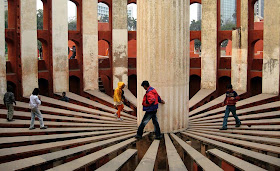
Misra Yantra:
Combines multiple functions, providing versatile measurements for different astronomical parameters. It comprises of the following five different yantras-
Dakshinottar Bhitti Yantra:
Measures the meridian altitude of celestial objects.Samrat Yantra:
Measures time.Niyat Chakra:
Determines the position of celestial objects.Karka Rasivalaya Yantra:
Measures the latitude and longitude of celestial objects.Western Quadrant:
Determines the altitude or angular height of objects in the sky.The Mishra Yantra (Mixed Instrument), Is a Compilation of Five Different Instruments.
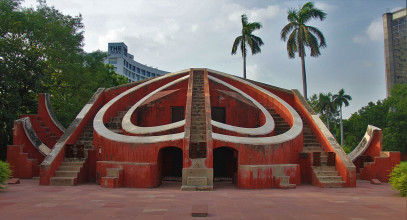
This combination allows for a broad range of astronomical measurements- such as determining the shortest and longest days of the year, exact noon times in various locations, and the declination of celestial objects.
Nadivalaya Yantra:
It measures the equatorial coordinates of objects in the sky. When the sun’s shadow falls on the circular plates, providing information about the celestial object’s position. relative to the equator.
Nadivalaya Yantra – Measures the Time to an Accuracy of Less Than a Minute.
Digamsa Yantra:
It measures the azimuth (the horizontal angle) of celestial objects. The shadow cast by the central pillar shows the azimuth on the circular scale marked on the platform.
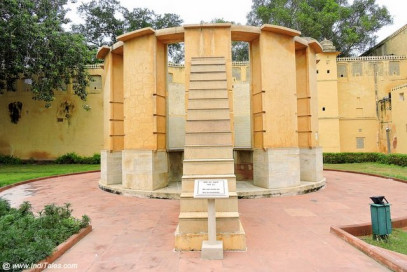
The Digamsa Yantra, This Cylindrical yantra measures the azimuth of celestial objects.
Shanku Yantra:
It is used for determining the solstices by observing the length of the shadow cast by the gnomon. The shortest shadow indicates the summer solstice, and the longest shadow indicates the winter solstice.
The Shanku Yantra, Is Integral for Understanding Solar Movements and Timekeeping In Traditional Indian Astronomy.
Disha Yantra:
It is used to determine the direction of celestial bodies. It helps in aligning other instruments and providing accurate directional references for observations.
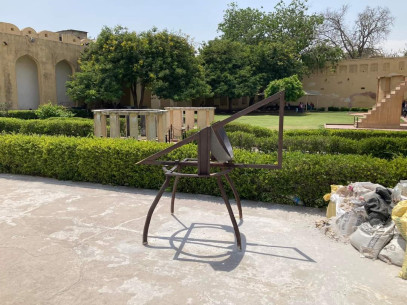
The Disha Yantra, Is used to showcase the directions and measures the angle of the sun with respect to true north.
Dhruva Yantra:
It is used to find the location of the Pole Star (Dhruva). This helps in aligning other instruments and serves as a reference for measuring the rotation of the sky.
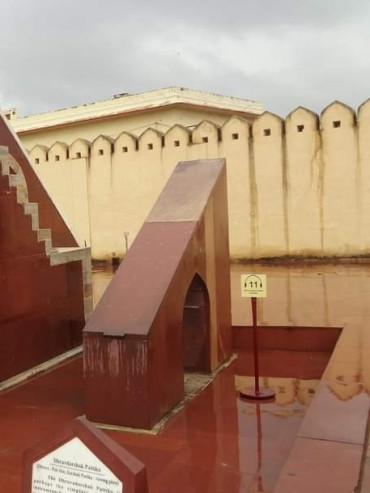
The Dhruva Yantra, an Ancient Pole Star Finder.
Kapala Yantra:
It measures the position and movements of celestial objects. The bowl’s surface is marked with coordinates, allowing observers to track the apparent movement of stars and planets across the sky. .
Kapala Yantra – potentially a prototype of Jai Prakash Yantra
Chakra Yantra:
Its primary purpose is to measure the declination of celestial objects.The declination of an object refers to its angular distance either north or south of the celestial equator. The instrument is aligned with the celestial axis, and the observer measures the angle between the observed celestial object and the celestial equator.
The Chakra Yantra, This Instrument Is a Ring, Which Is Used by Astronomers to Calculate the Coordinates of the Sun and the Hour Angle.
Each of these instruments was meticulously designed for precision and demonstrates the advanced astronomical knowledge and ingenuity of Maharaja Jai Singh II and his era.
Architectural Brilliance of the Jantar Mantras
The architectural brilliance of Jantar Mantar underscores the ingenuity and sophistication of ancient Indian astronomers. This observatory comprises a collection of intricate stone instruments, meticulously crafted to calculate planetary positions and interpret celestial phenomena.
These remarkable instruments stand as marvels of precision engineering, showcasing the advanced scientific thinking of their era. Let’s explore the architectural brilliance of each Jantar Mantar observatory:
Jantar Mantar, Jaipur
The Jantar Mantar in Jaipur is an outstanding example of architectural brilliance dedicated to astronomical observations. Maharaja Jai Singh II constructed this observatory, integrating ancient Indian, Islamic, and European astronomical principles into its design.
The observatory houses the Samrat Yantra, the largest sundial in the world. There are other instruments, such as the Jai Prakash Yantra and the Ram Yantra, that feature intricate geometrical designs that enable precise celestial observations. These instruments, constructed primarily from locally sourced sandstone and marble, demonstrate an advanced understanding of astronomy and engineering. The design principles reflect the rich heritage of Indian astronomical sciences, where mathematical precision is paramount.
The Jaipur observatory’s ability to measure time, track celestial objects and predict eclipses showcases the ingenious blend of functionality and aesthetics, making it a UNESCO World Heritage site.
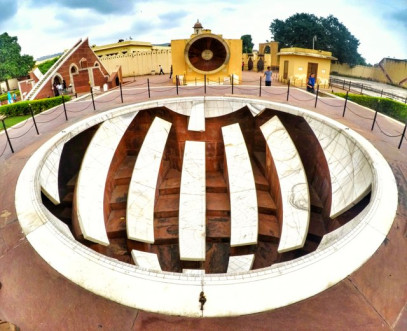
Jantar Mantar, Delhi
The Jantar Mantar in Delhi stands as a testament to the architectural and scientific ingenuity of the 18th century. the observatory features a collection of 13 instruments, each designed for specific astronomical functions.
The Misra Yantra, a composite instrument, is unique to Delhi and combines five different yantras for diverse measurements, including determining the shortest and longest days of the year. The materials used—red sandstone and marble—reflect the Mughal architectural influence prevalent during the period. The observatory’s strategic alignment with the city’s geographical coordinates ensures accurate observations.
The Delhi Jantar Mantar’s architectural brilliance lies not only in its precision but also in its integration of Islamic and Indian architectural styles, making it a significant site for both scientific and historical study. The observatory’s enduring structures highlight the sophisticated blend of art and science, rooted in ancient Indian astronomical traditions.
Jantar Mantar, Ujjain
Situated in Ujjain, a city historically known as India’s Prime Meridian, the Jantar Mantar observatory embodies the architectural and scientific prowess of its era. Maharaja Jai Singh II constructed this observatory to enhance the precision of astronomical measurements.
Instruments like the Samrat Yantra and Nadivalaya Yantra, made from local stone and marble, are still operational today. The observatory’s design incorporates ancient Indian astronomical knowledge, particularly relevant given Ujjain’s historical significance in Hindu cosmology and astronomy. The instruments are meticulously positioned to match Ujjain’s latitude, ensuring accurate celestial observations.
The architectural layout and construction techniques of the Ujjain Jantar Mantar showcase the city’s long-standing tradition as a hub of learning and astronomical study, seamlessly integrating cultural heritage with scientific innovation.
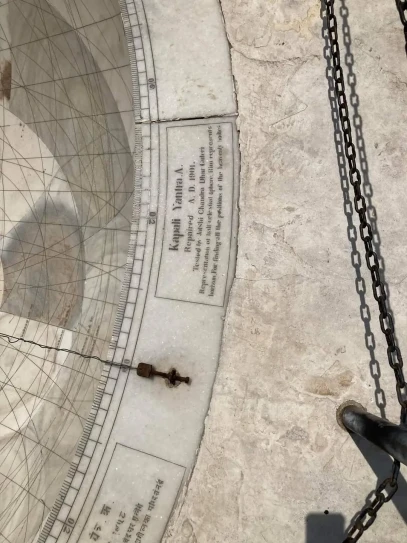
Jantar Mantar, Varanasi
The Jantar Mantar in Varanasi, built on the banks of the sacred Ganges, is a remarkable fusion of architectural elegance and scientific precision. Smaller in scale compared to its counterparts in Jaipur and Delhi, this observatory nevertheless showcases a deep understanding of astronomy. The Samrat Yantra and Chakra Yantra are key instruments, designed for timekeeping and measuring the declination of celestial objects.
Constructed from sandstone and lime plaster, the observatory’s instruments are aligned with Varanasi’s geographical coordinates, enabling accurate celestial measurements. The design principles reflect the influence of ancient Indian astronomical texts and local architectural styles.
The Varanasi Jantar Mantar serves as a crucial link in the chain of observatories, highlighting the city’s historical and cultural significance in the study of astronomy, and exemplifying the advanced scientific knowledge of the time.
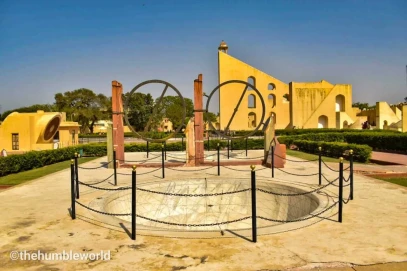
Jantar Mantar, Mathura
The Jantar Mantar in Mathura, though less known and visited, was a significant piece of architectural and astronomical heritage. Built using local stone and mortar, the observatory was featuring essential instruments like the Samrat Yantra and Digamsa Yantra. These instruments was simpler in design compared to those in other cities.
The observatory’s construction was reflecting the regional architectural practices and the integration of ancient Indian scientific principles. But before 1857 The observatory was demolished.
Despite its demolition, the legacy of the Mathura Jantar Mantar lives on through the other surviving observatories built by Maharaja Jai Singh II, which continue to be studied and admired for their historical and scientific significance.
Enjoyed reading this! Consider reading,



